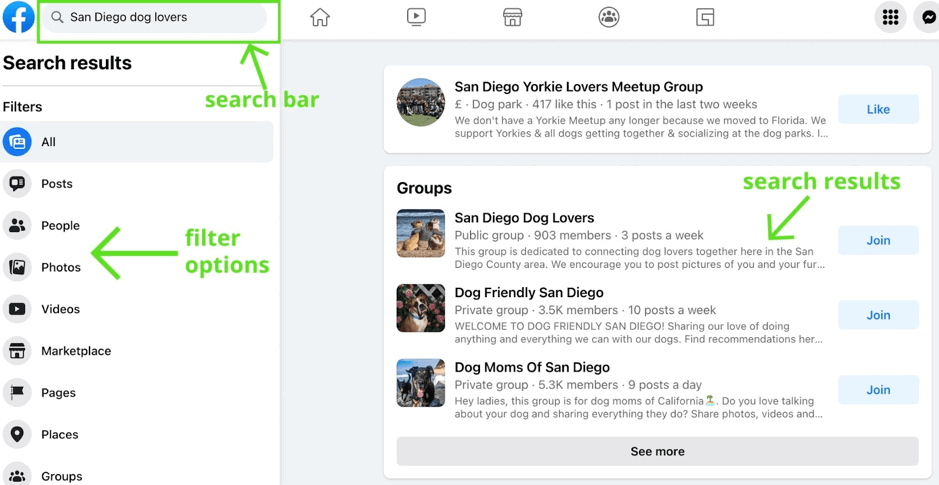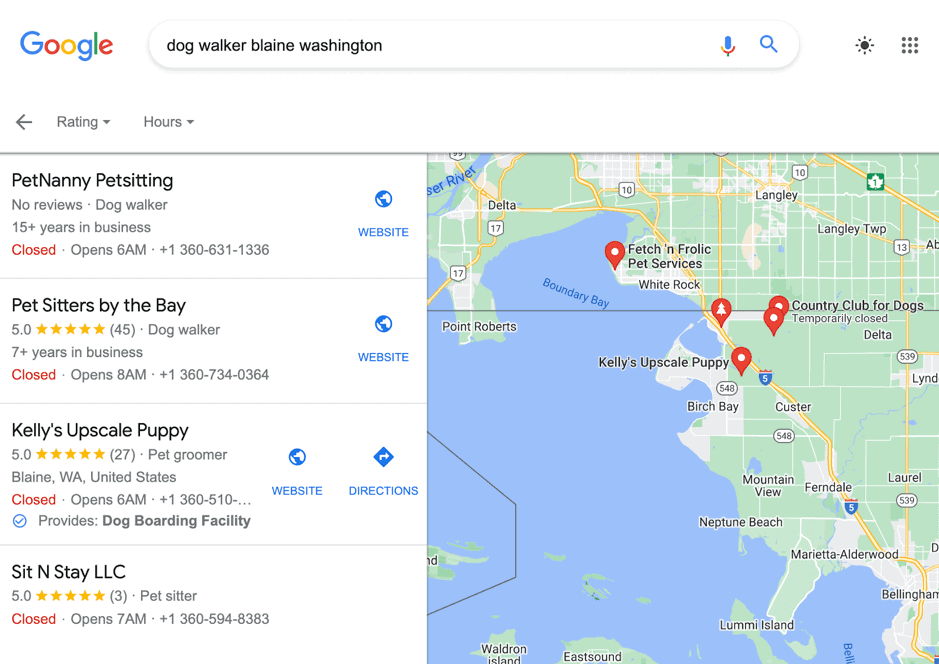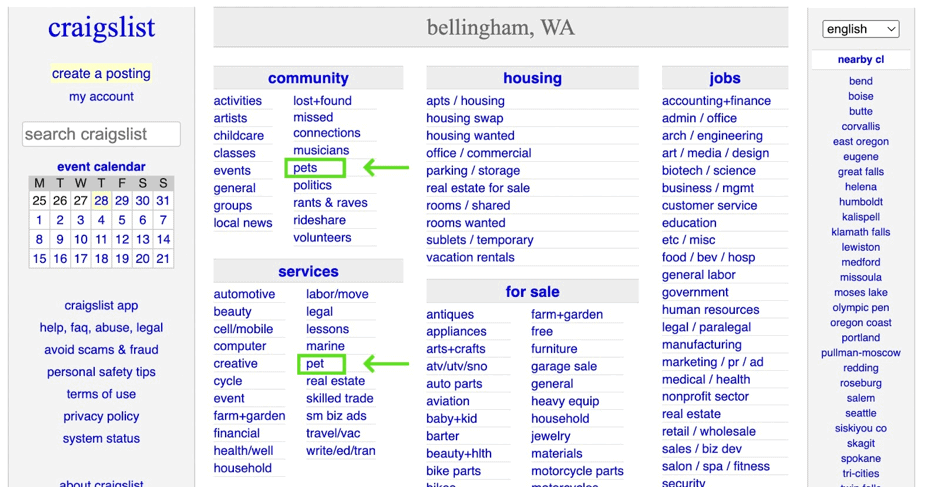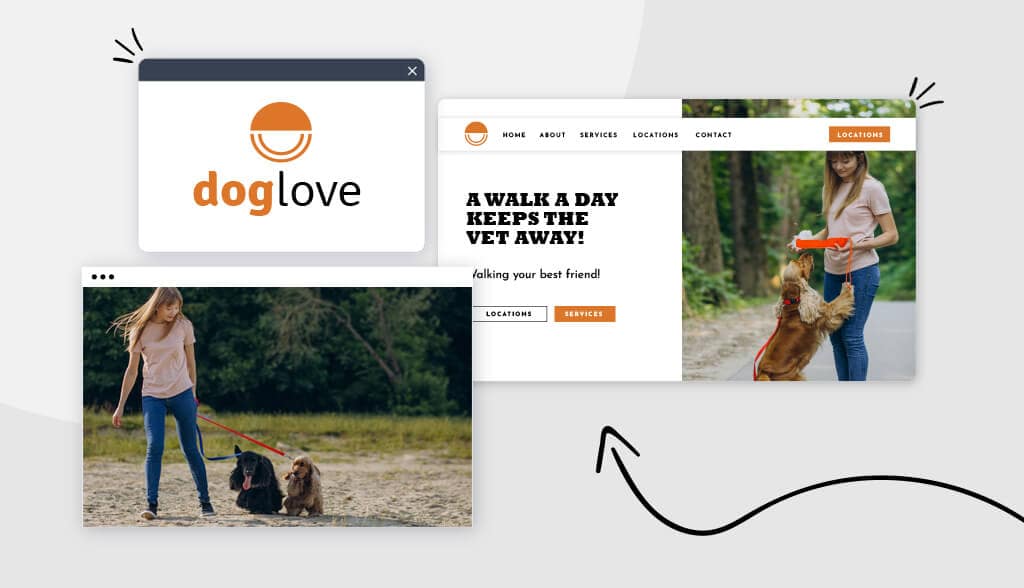You love dogs, exercising outside, and having flexible working hours. Well, it sounds like opening a dog-walking business is right up your alley.
If you’re unsure how to start your dream business, you’ve come to the right place. Here, you’ll learn the ins and outs of starting a dog walking business. So, let’s get started!
Make Sure This Business is Right for You
While the idea of walking dogs daily may sound like a dream, sometimes dreams don’t always match reality. You may have an image of frolicking in the fields with your doggies (and that may happen!), but it’s not always going to be like that. So, before going all in, make sure this is the right business for you.
Let’s be honest; not everyone can be a dog walker (at least a good one). But what makes a good dog walker? What are the characteristics people are looking for in a dog walker? A good dog walker has the following qualities:
Relevant experience
Even if this business is new to you, having experience with dogs (or having your own dog) is something most dog owners look for in a dog walker. They want to make sure their dog is in safe hands!
Stamina
I’m not saying you need to have a six-pack, but dog owners want to ensure that their dog will be tired after a walk with you. While not every dog enjoys long walks (take bulldogs, for example), a good dog walker should be able to keep up with the dog’s natural pace.
Responsibility
When a dog owner hands you the leash, they trust you with their friend. As a dog walker, you should act with the utmost responsibility. It’s their furbaby, after all!
While going for walks, you need to keep a close eye on the dogs and ensure they’re safe from harm’s way. Oh, and as a responsible dog walker, you’ll also want to carry extra poop bags, treats, and a first aid kit. Better to be safe than sorry.
Good communicator
I get it, life happens. But communication is key if you want to be a respectable and reputable dog walker. Sometimes you may be unable to fulfill your agreement; maybe there was an emergency, or you got the flu. But that doesn’t mean you can just ghost your clients.
Instead, you should have a plan B for when those situations happen. Perhaps contract another dog walker (with the dog owner’s permission) to take them out or offer a discount for the next walk.
Punctuality
Time matters. When you create a schedule with a client, it’s important to stick to it. For this, it’s essential to understand the needs of the dogs so you keep both the owner and pooch happy.
You’re an animal lover
I don’t know how I didn’t already say this one. But this is a given. If you want to be a good dog walker, you need to actually like dogs. If you don’t, this isn’t the business for you – maybe cat sitting is more your thing.
But seriously, sometimes you’ll have tough days with your dogs, but if you truly love what you’re doing, those days won’t be such a big deal.
Consider getting training or certifications
While this isn’t mandatory to become a dog walker, if you want to gain people’s trust and look more professional, taking a course or getting qualifications can help build your credibility and confidence.
Some examples of training and qualifications you can get are:
- Animal first aid
- Animal behavior training
- Animal care
Depending on the state you live in, centers or colleges may offer city and guild qualifications for dog walking, animal handling, animal nutrition, and pet sitting.
While you don’t need these qualifications, if you lack previous dog walking experience, they can help the owner feel relaxed and safe with their dog in your hands.
Consider Choosing a Target Market
It’s time to do a little research and establish a target market. While you may think all dog owners are your target market, you can narrow it down even further.
For example, perhaps you’ve noticed the dog walkers in your neighborhood only offer neighborhood walks. You can target dog owners with energetic dogs, offering them intensive hikes or walks out in nature.
This is called finding your niche and servicing a particular type of client. Let’s be honest, you’re not going to walk all the dogs in your area, but you don’t have to. Finding your target market will create a solid foundation for returning clients. Look at your competition, what they offer, and what’s missing. The “what’s missing” could potentially be what you’ll offer.
Establish Your Pricing Rates
Now it’s time to establish your pricing rates. This is important. You want to be able to cover your business costs and provide yourself with a livable income. So, before even coming up with a price, here are some important factors to consider:
What services will you offer?
Start simple – you don’t need 100 different services to attract clients. Remember, it’s about attracting your target audience. I recommend keeping it straightforward and simple. For example, services could include:
- 30-minute or 60-minute walks/runs
- Home visits
- Overnight stays
- Training
- Pet taxi
- Medication administration
Where are you located?
Where you live plays a role in how much you will charge clients. What you can charge may vary depending on how saturated the market is. However, by researching your competition (which I’ll get to in a moment), you’ll be able to understand the ongoing rates.
What are your expenses?
Are you working alone? Will you be picking up and dropping off pets with a car? Are you going to have a logo? A website? These are all expenses that you will take on when you open your business.
You want to make sure you profit, so your rates should cover your business expenses. I recommend writing down all your expenses beforehand on paper – you don’t want to miss anything.
Some common business expenses for dog walking are:
- Logo Design (we can help with that!)
- Website
- Management software (invoicing and scheduling)
- Insurance
- Transportation and gas
- Certifications
- Business license
- Pet first aid class
- Marketing (social media, newspapers, flyers, events)
- Dog walking equipment (leash, poop bags, first aid kit, etc.)
These expenses range from one-time purchases to recurring monthly/annual expenses, so keep that in mind when determining your overall business expenses.
What is your competition charging?
It’s time to do some market research. Look at the other dog walkers in your area, their services, and what they charge. This will give you a general idea of what clients are currently paying.
Are you offering luxury services? Have specific training or certifications? Your pricing may vary depending on how you position yourself. This rate calculator can help you come up with rates for specific services.
Register Your Business
Most local municipalities and states require businesses to have a business license before becoming operational. You’ll want to register with your local government to ensure your business is lawful.
For example, you can set your business up as a sole proprietorship; however, it offers fewer protections in comparison to other business entities such as an LLC (limited liability company).
If you choose to register your business as an LLC, there are some benefits. One benefit is that an LLC separates your personal and business assets. It also creates separation between you and any legal issues your business may face.
This is particularly useful for a dog walking business. With an LLC, if an injury or accident happens to one of your client’s pets, you most likely won’t be held personally liable (as long as you maintain your legal structure properly). For more information on forming an LLC, click here.
Get the Right Insurance
I’m just going to say it – you need insurance. Sure, you can run your business without it, but if something happens to one of your client’s dogs, whether it’s an injury or a serious accident, the finger will be pointed at you.
Whether there are damages incurred on your client’s property or a dog gets off leash and gets into an accident, you want to be covered. Here are some reasons you need insurance:
- Protect yourself financially
- Dog-walking business insurance is affordable (so why take the risk?)
- All professional businesses have liability insurance
Luckily, there are several providers that offer pet care insurance. Here are some of the most popular ones among dog walkers:
- Pet Sitters Associates
- Business Insurers of the Carolinas
- Kennel Pro
- Pet Care Insurance
A comprehensive dog-walking business insurance policy can protect you if something goes wrong. To make sure you’re fully covered, consider speaking with a legal professional, insurance specialist, and local government to ensure you have the right coverage for your dog-walking business and know what’s not covered in your policy.
Set Up an Onboarding Process
So, what happens when someone contacts you about walking their dog? What’s the next step? Having an onboarding process will create structure and ease when welcoming new clients.
Have a meet and greet
Take the time to meet with the owner and dog before the first booking. This first introduction is important for both you and the client. You’ll meet the dog and get a feel for its behavior and general energy. For the client, they’ll gain trust and feel more comfortable with you.
During this meeting, you should cover the following:
- Ask questions about the dog’s past (training, behavior, past dog walkers, etc.)
- How the dog behaves with other dogs
- The needs of the dog
- Vaccinations (are the mandatory vaccines updated?)
- The client’s expectations
- The dog’s collar information has the owner’s name and number
- Any important information (medication, etc.)
- Go over all paperwork and sign the contract
- Engage with the dog to gain its trust
Note that some clients may request another meet and greet before their first booking – which is completely fine. Leaving their beloved pet in someone else’s hands is hard for many dog owners.
If this is the case, to help them feel more comfortable, you can always suggest having a private dog walking session with the owner and the dog.
Create a dog-walking contract
A dog-walking contract doesn’t just protect your business; it also protects your client and keeps you both on the same page. When creating a dog-walking contract, it should include:
Service agreement
A service agreement describes all the services you will provide the client. It clearly outlines everything you will offer each dog-walking session. For example, you could offer a simple 30-minute dog walk, hike, or run.
The service agreement would clearly state what the client should expect from your service. It also lists the terms and policies. Before taking on any client, they need to agree and sign your service agreement.
Here’s a free service agreement template you can use (make sure to read it thoroughly before using it for your business).
Vet release form
A vet release form gives your business permission to obtain veterinary care for the client’s pet in an emergency. This document should outline the procedure taken during emergency situations. Here’s a free veterinary release form template you can use (read thoroughly before using it for your business).
Key handling form
A key handling form is extremely important if you have a copy of your client’s house keys. And once your business grows, you will have more and more keys in your possession.
A key handling form simply ensures that both you and the client know how many keys you have in possession, the security system information and that you will not copy or distribute their keys/personal security information. Here’s a sample of a key handling form.
Payment authorization form
A payment authorization form is a crucial part of accepting payments. The payment authorization form should provide clear instructions to your clients on the payment plan (bi-weekly, monthly payments, etc.) and how they can pay their invoices.
If they are paying via credit card, you must be clear about when they will be charged. Here’s a sample of a payment authorization form.
Cancellation policy
There are gonna be some days where things aren’t going to work out as planned. A client could cancel for a variety of reasons, and these cancellations could happen at the last minute.
While it’s not the end of the world, you should have a policy in place so there isn’t any confusion about what will happen if a client cancels. For a detailed rundown on creating a cancellation policy for your dog walking business, click here.
Use the right tools to stay organized
It’s a given you’re going to need some poop bags and a leash to get your business started, but other tools can help you stay organized as you gain more clients.
Software like TimeToPet, Scout, and PetSitterPlus are management tools that help you perform scheduling, invoicing, and client management. While you may not need this initially, as your business grows, using management software can help you stay organized.
Build a Client List
You’ve done all the paperwork and checked everything off your list – it’s official, you’re a registered business! Congratulations! But now is when the real work starts. It’s time to build a client list. The good news is you don’t need a big budget to market your new dog-walking business. Here are some ways to get new clients:
Join local social media groups
You don’t need to create a bunch of ads on Facebook or Instagram. Instead, go on Facebook and look up local dog groups in your area.
For example, if you live in San Diego, you can search “San Diego dog lovers” or “San Diego dog walking” and see what pops up. The image below shows the search results when I look up “San Diego dog lovers” in the Facebook search bar.

Local shelter groups are also good places to network and connect with the dog community.
Network at your local dog park
You need to be where your clients are and what’s a better place than the local dog park? If you have a dog park in the area, go there. They may have a notice board where you can post flyers advertising your services.
If you have your own dog, take them to the park and mingle with other dog owners. It’s a great way to build relationships while showing off your experience with dogs (and your pooch gets a workout!).
Flyers/handouts
Flyers and handouts are a great way to advertise your business to the local community. You can post them around town, dog parks, veterinary clinics, or any pet-related business or service, including shelters. The more pet owners who see your business, the better.
Get listed on Google
We all know the power of Google and how important it is to appear in the search results. Help pet owners discover your business by getting listed on Google. What does this mean? With a Google Business Profile, the next time someone goes on Google and searches “dog walkers near me,” your business information will pop up. Having a Google Business Profile opens a lot of doors for your business. It helps your business:
- Engage with customers
- Gain audience insights
- Showcase your business
- Perform local SEO
- Build client trust through reviews
For example, I just Googled “dog walker Blaine Washington.” The image below shows the search results for all businesses that identify as dog walkers/sitters.

Customer referral program
This may be a challenge at first, but once you get one or two clients, a customer referral program will help boost your business. For example, you can offer 1 free walk for every referral a client gives you. That way, they get a free walk, and you get a new client. It’s a true win-win for everyone.
Give Craigslist a try
Don’t underestimate the power of Craigslist. You’d be surprised how many people use Craigslist to search for services and products.

You can make a post in the pet section and the community section of Craigslist. Create a post and direct people to your website without spending a penny (sounds good to me!).
Attend local dog events
Many dog walkers make the mistake of not putting themselves out there when they first start. Don’t be like the others – avoid their mistakes. You want your business to grow quickly, so get out there and get involved in the local dog community.
Search for local dog events in your area. It’s worth being a vendor and having your own booth where you can advertise your services and learn more about your business. Print out a sign with your logo and website and offer something free like a doggie bandana, treat bags, or stickers. Oh, and don’t forget your business cards.
Word-of-mouth
Word-of-mouth marketing is extremely effective for dog-walking businesses. People trust other dog owners’ recommendations when it comes to their furry friends. And it makes sense.
Post photos walking your client’s dogs on social media – they can repost onto their social media profile. “User generated content” does an amazing job of spreading word of your business.
Once you get a couple clients, ask for testimonials/reviews of your services. You can then repost the reviews onto your website and social media channels.
Over to You
Are you ready to start your dog-walking business? If, after reading this post, you’ve decided that dog walking is the right career path for you, now it’s time to take the above steps and put them into action.
While starting your dog walking business, refer to this post to make sure you’re covering each step needed. That way, you’ll build your business as smoothly as possible.
